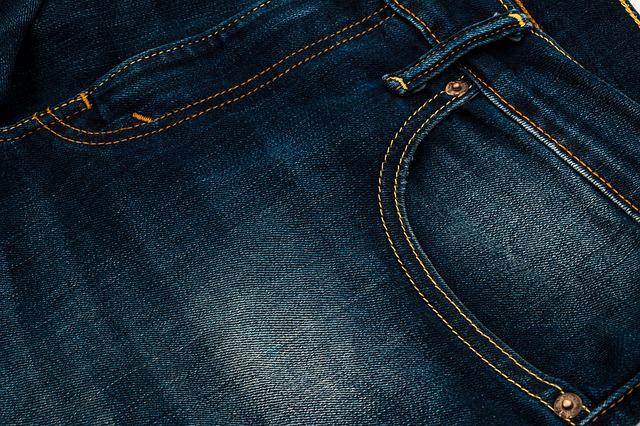Want to minimize your environmental footprint? A Pew Research Center survey found that three-quarters of U.S. adults are concerned about the environment. In light of Earth Day, there’s no better time than the present to take action. Following these six eco-friendly tips on maintaining jeans, for instance, will minimize your environmental footprint.
#1) Choose 100% Denim Jeans
When shopping for jeans, check the tag or description to see what they are made of. Jeans made of 100% denim are better for the environment than those made of denim and a synthetic fabric.
Denim is an organic fabric, meaning it’s all natural. Synthetic fabrics like nylon are not all-natural. They are derived from chemicals. By choosing jeans made of 100% denim, you can rest assured knowing that they are all natural. Jeans made of 100% denim don’t contain any synthetic fabrics in their construction. Rather, they are made entirely of denim, which is essentially cotton.
#2) Wash Less Frequently
You don’t have to wash your jeans each time you wear them. As long as they aren’t visibly dirty, you can typically wear them multiple times. Doing so, of course, is good for the environment. Washing your jeans less frequently will preserve water and energy.
Jeans also last longer when washed less frequently. Washing machines are aggressive. As your jeans tumble around inside of the drum of a washing machine, they’ll degrade. You may not notice any signs of damage initially, but washing your jeans dozens or hundreds of times may eventually degrade them. Therefore, you should consider washing them less frequently. It’s good for your jeans, and it’s good for the environment.
#3) Wash in Cold Water
In addition to washing them less frequently, you should consider washing your jeans in cold water. It takes water to wash clothes, including jeans. A typical front-loading washing machine uses over 12 gallons of water per load, whereas a top-loading washing machine uses over 19 gallons of water per load. Hot water, though, requires energy in the form of electrical or gas as well.
If you wash your jeans in hot water, you’ll consume energy. Water heaters are powered by electricity or natural gas. Regardless of which type of water heater you have, it will use electricity as it heats up the water. Washing your jeans in cold water, on the other hand, won’t consume any energy to heat up the water. To minimize your environmental footprint, choose the cold water setting when washing your jeans.
Some people assume that cold water isn’t as effective at removing dirt and stains as hot water. In reality, the opposite is true. Cold water is actually more effective at removing stains. If you wash your jeans in hot water, it may cause stains to set. Hot water can set stains so that they become harder or even impossible to remove. Cold water, conversely, will rinse away superficial stains without causing them to set.
#4) Wash Full Loads
Another eco-friendly tip is to wash your jeans in full loads. In other words, don’t wash a pair of jeans by themselves or with just one or two other garments. Washing machines use roughly the same amount of water regardless of the load size. As previously mentioned, most washing machines use about 12 to 19 gallons of water per load. Even if you only wash a single pair of jeans, they’ll still use this same amount of water.
Washing full loads will conserve water. If your jeans are dirty, place them in a laundry basket until you have enough dirty clothes for a full load. You don’t have to wash them immediately. Waiting until you have a full load means you’ll save water. Washing jeans in full loads is just one more tip to reduce your environmental footprint.

#5) Line Dry
After washing your jeans, you’ll need to dry them. Jeans soak up a lot of water. Cotton is an absorbent fabric, and most jeans are made of cotton-based denim. When your jeans come out of the washing machine, they’ll probably be soaked. But that doesn’t mean you should toss them in the dryer. While using a dryer is always an option, a more eco-friendly solution is to line dry your jeans.
Line drying is exactly what it sounds like. It involves hanging on clothes on a line to dry. Also known as air drying, line drying doesn’t require any energy. To line your jeans, you just need a line. You can run a line between two trees outside of your home, for example. You can then hang your wet jeans on this line to dry. Line drying takes longer than using a clothes dryer, but it doesn’t require any energy.
While most people prefer to line dry their jeans outdoors, some of them do it indoors. If it’s raining outside, for instance, you may want to line dry your jeans indoors. You can typically line dry jeans and other clothes indoors by using a shower rod. As long as the shower rod is hanging over your tub, you can use it to line dry your jeans. Moisture will drip down off your jeans and into the tub.
#6) Repair Damage
If your jeans become damaged, try to repair them. You don’t have to throw away a pair of jeans just because they are missing a button. Buttons are relatively easy to replace. You can sew new buttons into the fly or other parts of your jeans. All you need is a needle and some thread. You can attach the new button to your jeans with a needle and some thread. As a result, you won’t have to throw away your jeans, nor will you have to buy a new pair.
By repairing minor forms of damage such as missing or loose buttons, you’ll get more use out of your jeans. You can make your jeans last for years if not decades by repairing them. Not only will this save you money, but it will reduce your environmental footprint.











